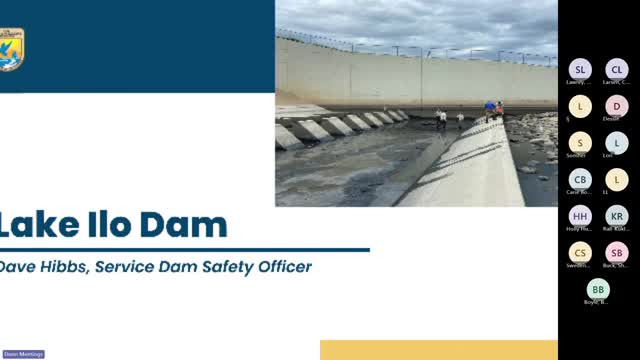Dam safety officer reveals urgent Lake Islo rehabilitation plan
July 17, 2024 | Dunn County, North Dakota

This article was created by AI summarizing key points discussed. AI makes mistakes, so for full details and context, please refer to the video of the full meeting. Please report any errors so we can fix them. Report an error »

The U.S. Fish and Wildlife Service is moving forward with a significant rehabilitation project for the Lake Ilo Dam, originally constructed in the mid-1930s and modified in the 1990s. During a recent government meeting, Dave Hibbs, the service's dam safety officer, outlined the critical issues surrounding the dam, primarily focusing on seepage detected in the right abutment.
Following a comprehensive review, the team identified a persistent wet spot that raised concerns about the dam's integrity. Historical records indicated that this seepage was linked to coal seams in the area, which allow water to flow from the reservoir through the dam structure. This seepage poses a risk of creating a \"pipe,\" potentially leading to an uncontrolled release of water and dam failure.
To address these issues, the rehabilitation plan includes the installation of a filter wall designed to capture and control the flow of water, preventing further erosion of embankment materials. The filter wall will consist of a vertical structure with a two-stage filter system, allowing water to pass while blocking embankment material from entering. Additionally, a filter blanket will be implemented to capture any unknown seepage points that may not have been previously identified.
The project aims to enhance the safety and monitoring capabilities of the dam, ensuring that any increases in seepage flow can be detected early. The rehabilitation work is expected to involve excavations up to 25 feet deep, with provisions for ongoing inspections to maintain the integrity of the filter system.
As the project progresses, the U.S. Fish and Wildlife Service emphasizes the importance of these measures to safeguard the surrounding community and the environment.
Following a comprehensive review, the team identified a persistent wet spot that raised concerns about the dam's integrity. Historical records indicated that this seepage was linked to coal seams in the area, which allow water to flow from the reservoir through the dam structure. This seepage poses a risk of creating a \"pipe,\" potentially leading to an uncontrolled release of water and dam failure.
To address these issues, the rehabilitation plan includes the installation of a filter wall designed to capture and control the flow of water, preventing further erosion of embankment materials. The filter wall will consist of a vertical structure with a two-stage filter system, allowing water to pass while blocking embankment material from entering. Additionally, a filter blanket will be implemented to capture any unknown seepage points that may not have been previously identified.
The project aims to enhance the safety and monitoring capabilities of the dam, ensuring that any increases in seepage flow can be detected early. The rehabilitation work is expected to involve excavations up to 25 feet deep, with provisions for ongoing inspections to maintain the integrity of the filter system.
As the project progresses, the U.S. Fish and Wildlife Service emphasizes the importance of these measures to safeguard the surrounding community and the environment.
View full meeting
This article is based on a recent meeting—watch the full video and explore the complete transcript for deeper insights into the discussion.
View full meeting
